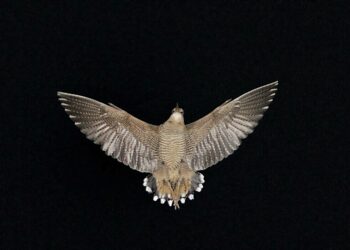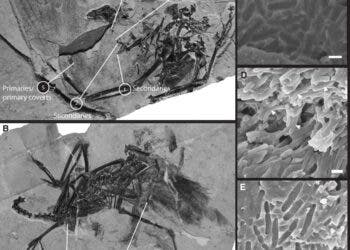
On a microscopic scale, the extravagant eyespots of a peacock’s tail are built like optical machines — arrays of nanoscale rods and sheaths arranged with mathematical precision. But these intricate architectures, honed by evolution to dazzle mates with shimmering blues and greens, turn out to be capable of something even stranger: lasing.
Researchers have found that when these feathers are soaked in a fluorescent dye and pulsed with light, they emit sharp beams of laser light. The phenomenon doesn’t arise from pigments or surface coatings, but from hidden structures buried within the feather’s fibers — structures that appear to trap and amplify light in a way previously unknown in biology.
The findings mark the first time a laser cavity — a fundamental component of any laser — has been found operating in an animal tissue.
More Than Just a Pretty Feather

The vivid color of a peacock feather is not based on pigment but is an example of structural colour. Materials with pigment-based color, absorb certain wavelengths of light and reflect others. Meanwhile, structural color arises from the physical interaction between light and nanoscale structures. In the eyespots of the tail feathers, nanoscopic rods of melanin coated in keratin form highly regular and finely spaced arrays (repeating structures on the scale of hundreds of nanometers), reflecting light in predictable, iridescent patterns.
In peacock feathers, these structures lie inside slender filaments known as barbules. These periodic arrangements function like naturally occurring photonic crystals — materials that allow certain wavelengths of light to pass while excluding others.
The new study began with an audacious question: could these same microstructures do more than reflect light? Could they, under the right conditions, amplify it?
Lasers in the Eyespots
To test the idea, the researchers applied rhodamine 6G, a dye commonly used in laboratory lasers, to the eyespots of peacock feathers. Researchers stained and dried each sample multiple times to allow the dye to fully permeate the internal structures. They then pulsed the dyed feathers with 532-nanometer laser light — green, and close to rhodamine’s absorption maximum. And they detected something remarkable.
Out of the feathers emerged laser light: thin, bright spectral lines at 574 and 583 nanometers, in the yellow-orange range. These emissions were unmistakably narrow, coherent, and pump-dependent — the three hallmarks of true lasing, rather than the mere glow of ordinary fluorescence.
The scientists saw the same laser lines in every part of the feather’s eyespot, regardless of color. This can’t be a coincidence. “It’s like rolling two 100-sided dice and always getting the same two numbers,” said physicist Nathan Dawson, the study’s lead author.
A Hidden Architecture In Peacock Feathers
Laser emission has occasionally been observed in biological materials, but almost always as a form of “random lasing”. This is an effect produced when light scatters chaotically through disordered media. Random lasers have been reported in everything from parrot feathers to human tissue. But their emissions are unpredictable, shifting in wavelength with even small changes in structure or illumination.
The peacock feathers showed none of this randomness. No matter which colored region of the feather the team tested, the same two laser lines emerged, at nearly identical wavelengths. The results were consistent across multiple feathers and multiple experimental runs.
If these were random laser modes, you wouldn’t see the same peaks every time. The consistency means there’s a highly regular feedback structure doing the work.
The authors propose that tiny, previously uncharacterized structures — perhaps protein granules or nanoscale keratin cavities — form the resonant cavities required for lasing. These hypothetical resonators, embedded within the feather barbules, would need to be extraordinarily consistent in size and optical properties to produce the uniform spectral lines observed in the experiments.
Indeed, calculations suggest the two main laser lines would correspond to cavities with optical lengths of roughly 92 to 93 nanometers — tiny even by biological standards. Gallery modes, another possible explanation, were ruled out because such modes require smooth, circular geometries not found in peacock feathers. Random scattering was similarly discounted due to the spectral stability.
Toward a Biological Laser Toolbox
What’s the evolutionary purpose of this built-in laser cavity? Likely, there isn’t one.
There’s no evidence the peacocks are using these laser properties for communication or display. It’s probably just a byproduct of the way their feathers are built.
Still, the implications are significant. This discovery could open a new window into how regular structures are arranged within living materials. Measuring laser emission might one day help detect tiny structural features in cells, tissues, or even viruses — anywhere dye can be applied.
Biological lasers are already being explored for use inside the body, in imaging, diagnostics, and targeted therapy. But implanting artificial laser cavities comes with complications. What if nature has already built some?
This could be the first step toward fully biocompatible lasers. Structures like these might one day be used as sensors inside the body.
“I always like to think that for many technological achievements that benefit humans,” Dawson told Science Mag, “some organism somewhere has already developed it through some evolutionary process.”
The findings appear in the journal Scientific Reports.






